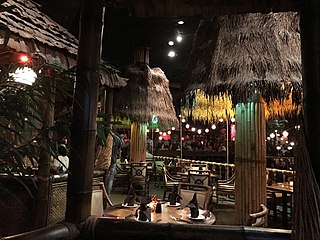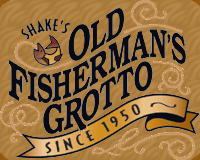
New England cuisine is an American cuisine which originated in the New England region of the United States, and traces its roots to English cuisine. It is characterized by extensive use of seafood and dairy products, resulting from its historical reliance on its seaports and fishing industry, as well as extensive dairy farming in inland regions.

Tiki culture is a motif of exotically decorated bars and restaurants catering to an escapist longing for travel to tropical regions of the South Pacific. Featuring mock tiki carvings and complex, alluringly named alcoholic drinks, it eventually influenced residential recreation.
Donn Beach was an American adventurer, businessman, and World War II veteran who was the "founding father" of tiki culture. He is known for opening the first prototypical tiki bar, Don the Beachcomber, during the 1930s in Hollywood, California, which was expanded to a chain of dozens of restaurants throughout the United States. He later built the International Market Place and additional establishments in what was then the Territory of Hawaii. He married three times.

Trader Vic's is a restaurant and Tiki bar chain headquartered in Emeryville, California, United States. Victor Jules Bergeron, Jr. founded a chain of Polynesian-themed restaurants that bore his nickname, "Trader Vic". He was one of two people who claimed to have invented the Mai Tai. The other was his amicable competitor for many years, Donn Beach of the "Don the Beachcomber" restaurants.

A cocktail umbrella or paper parasol is a small umbrella made from paper, paperboard, and a toothpick. They are frequently associated with tropical drinks and Tiki bars and used as a garnish decoration. They are also used in desserts or other foods and beverages.

Tiki mugs are large ceramic cocktail drinking vessels that originated in tiki bars and tropical-themed restaurants. The term "tiki mug" is a blanket term for the sculptural drinkware even though they vary in size and most do not contain handles. They typically depict Polynesian, mock-Polynesian, tropical, nautical, or retro themes, and as the term is used generically do not always emulate a tiki. When used to serve drinks they are frequently garnished with fruit or decorative drink umbrellas and swizzle sticks.

A pu pu platter, pu-pu platter, or pupu platter, is a tray of American Chinese or Hawaiian food consisting of an assortment of small meat and seafood appetizers. A typical pupu platter, as found in American Chinese cuisine, might include an egg roll, spare ribs, chicken wings, chicken fingers, beef teriyaki, skewered beef, fried wontons, fried shrimp, crab rangoon and things of that nature, accompanied by a small hibachi grill.

A tiki bar is an exotic-themed drinking establishment that serves elaborate cocktails, especially rum-based mixed drinks such as the Mai Tai and Zombie cocktails. Tiki bars are aesthetically defined by their tiki culture décor which is based upon a romanticized conception of tropical cultures, most commonly Polynesian. Some bars also incorporate general nautical themes or retro elements from the early atomic age.
A Scorpion Bowl is a communally shared alcoholic tiki drink served in a large ceramic bowl traditionally decorated with wahine or hula-girl island scenes and meant to be drunk through long straws. Bowl shapes and decorations can vary considerably. Starting off as a single-serve drink known as the Scorpion cocktail, its immense popularity as a bowl drink in tiki culture is attributed to Trader Vic.

Volcano bowls are ceramic drinkware originally associated with mid-20th century American tiki bars and tropical-themed restaurants. Drinks served in volcano bowls are typically rum-based, mixed with tropical fruit juices and other liquors such as brandy, vodka, and triple sec, and garnished with fruit. The Flaming Volcano cocktail is especially associated with this drinkware.
Barbadian cuisine, also called Bajan cuisine, is a mixture of African, Portuguese, Indian, Irish, Creole and British background. A typical meal consists of a main dish of meat or fish, normally marinated with a mixture of herbs and spices, hot side dishes, and one or more salads. The meal is usually served with one or more sauces.

The Zombie Hut was a Hawaiian/Polynesian-themed restaurant, nightclub and Tiki bar located on Freeport Blvd. between Florin Road and Sutterville Road in Sacramento, California that originally opened in 1945 after the end of WWII and continuing for 45 years until its closing in 1990. Inspired by the 1930s Tiki craze, the restaurant was owned by Johnny Quaresma from 1945 to 1952 when Ed and Beatrice Hill purchased the business. The Hills eventually sold the Zombie Hut to Bruce Brooks, who owned it until its closing in 1990.

Old Fisherman's Grotto is a restaurant in Fisherman's Wharf, Monterey, California. Old Fisherman's Grotto was opened in 1950 by restaurateur Sabu Shake, Sr. The restaurant serves seafood, steaks and Italian cuisine. Their Monterey Style Clam Chowder was named best clam chowder in Monterey 15 years in a row.
Monterey's Fish House is a seafood restaurant in Monterey, California in the United States.
Bistro Moulin is a restaurant in the New Monterey neighborhood of Monterey, California in the United States that serves French cuisine.
Montrio Bistro is a New American restaurant in Monterey, California in the United States.
Eryn Reece is an American bartender. She is the bar director for Banzabar and Freemans Restaurant, both in New York City. In 2013, Reece was named Speed Rack National Champion. In 2014, The Daily Meal named her one of the top 25 bartenders in the United States. Reece has been profiled in, and her work featured in, PUNCH, The Daily Beast, Maxim, WPIX, The Spirits Business, Thrillist, and other media outlets.

Circa 33 is a bar and restaurant in southeast Portland, Oregon's Sunnyside neighborhood, in the United States.












